-
Article tells you about the folk dances of mainly
Assam India as performed at the Kaziranga National Orchid and Biodiversity Park in
December 2018.
Kaziranga
National Orchid and Biodiversity Park is one of most fascinating places in Assam.
All must visit to experience the beauty of the park. The park is located at a distance
of about 2 kms from the Central range of Kaziranga, i.e. Kohora Chariali.
This
park has multiplied the glory of the Kaziranga in many ways; like it consists
of different kinds of orchids, herbal plants, museum, an artificial lake and a
performance area inside the park.
Every
evening, there is a cultural programme conducted in the park especially for visitors.
The program is a must see. The deeper intent is to promote and introduce the
different ethnic cultures and folk music of North East India especially Assam.
Editor – I visited the Biodiversity Park in December 2018, super, worth a visit. Whole area is lovely. The following dances were performed in the evening, the crowds loved every moment. This write up prepared with the help of Lekhapriya, compere for the evening program. She too was very good.
This
article gives you a brief write-up of each dance form, format is name of dance,
pic and about it.
1. The Jhankar
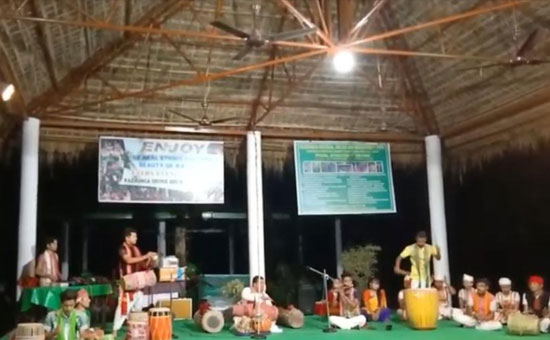 Performance at Kaziranga Biodiversity Park.
Performance at Kaziranga Biodiversity Park.
Jhankar is the instrumental
programme of folk music and the classical music of Assam. Here, all kinds of
instruments are played by those who excel in performing a particular
instrument.
2. The Bhortal Nritya
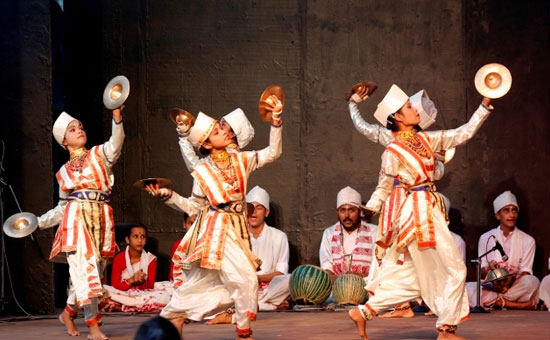
Bhortal
Nritya is one of the most popular traditional dances which is performed in
Assam. It originated at Barpeta i.e. also known as Satra Nagar and has
its origin in classical arts and is an extension of Sanskrit culture.
This
dance was developed by a well-known Sattriya artist Narahari Burha
Bhakat. It is unique in its style of performances.
Basically,
it is performed in groups. People of all age groups and cultural background can
enjoy this dance. Six or seven dancers generally present the Bhortal dance
together. This dance can be performed in large groups as well.
It is performed to a very fast beat known as ‘Zhiya Nom’. The dancers are
equipped with cymbals while performing this dance. This dance reflects the rich
cultural heritage of Assam.
3. Bagurumba Dance
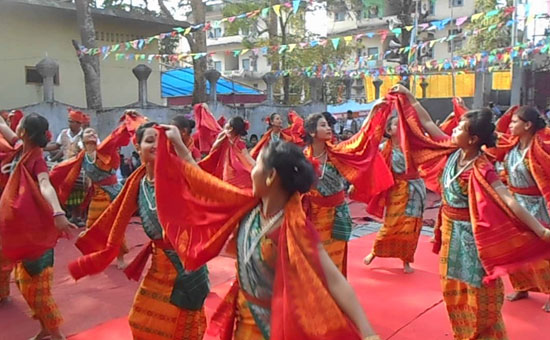
Bagurumba
is a folk dance of indigenous Bodo tribe of Assam and Northeast India. This is
a spring time dance.
The Bagurumba dance is also called ‘Butterfly dance’ because it resembles the movement of birds and butterflies. This dance is performed by Bodo women with their colourful traditional dress like dokhna, fasra and Aronai.
It
is usually performed during Bwaishagu festival of the Bodos in the Bishuba
Sankranti ie in mid-April.
This
Bwaishagu festival begins with the worship of cows and then the young
people bow down to their parents and other elders in the house. After that the Bathau
(Supreme Deity of Bodo) is worshipped by offering the deity chicken and zou
i.e. rice beer. This festival is celebrated with pleasure in all areas of Bodo
community and ends with a community prayer at Garjasali.
This
dance is performed after the hard plantation work of the Bodo people and helps
them relax. It is a most graceful and captivating dance of the Bodo tribe. This baguramba dance is traditionally passed on from to
one generation to another.
4. Hamzar Dance
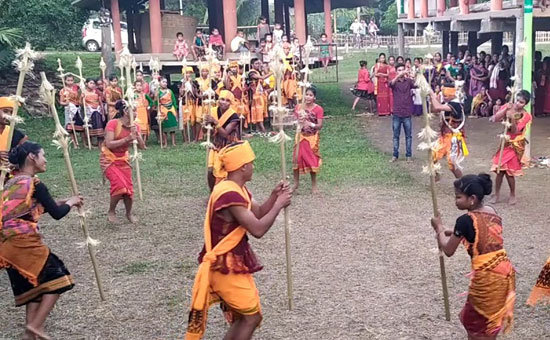
The term ‘Hamzar’ is composed of two root steams, i.e. ‘Ha’ meaning ‘Earth’ and ‘Mazar’, meaning ‘in the midst of forest’.
This
dance is a folk dance of Rabha tribe in Assam and related to agriculture. Rabha
is an indigenous Assamese community.
In
this dance, you can see how the Rabha people cultivate paddy on land cleared of
forest in the hills and plains.
The tradition of Hamzar has well defined roles for the Rabha man and Rabha woman. While the Rabha men clear the land by cutting down the trees of the forest, the women folk, scrub and sweep the land. Both men and women take part in ploughing the land and sowing the seeds. In Assamese, it is called “Kheti Bati Dance”
5. Khomsi Mishwa Dance

Khomsi
Mishwa Dance is a folk dance of Tiwa tribe of Assam.
Tiwa
is an indigenous community inhabiting the states of Assam, Arunachal Pradesh,
Meghalaya and Manipur.
This
dance performed on Makar Sankrati and is associated with the worship of the
Agni Devata.
6. Bamboo Dance
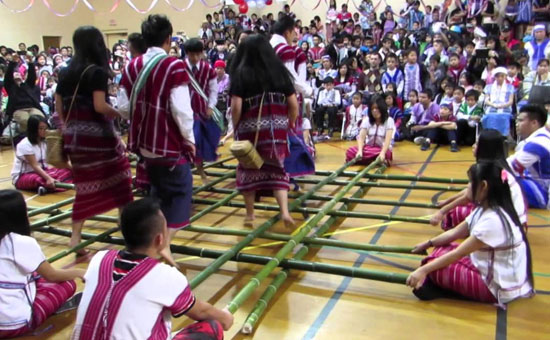
Bamboo dance is a folk dance of Karbi people. Generally, these folk dances are group dances. This bamboo dance also known as ‘Cheraw Dance’.
Cheraw
is originally a funeral dance, but it is now performed during festivals,
marriage or to celebrate a bumper harvest. Bamboos are used in the performance of the
dance, from which the dance is named so. Both men and women come together and
perform the bamboo dance of Mizoram where it is very popular.
While
the men sit on the ground facing each other and hold the bamboos, the women
dance between the bamboos. This dance is a set of skilfully formulated moves
which involves movement of bamboo staves. While the man moves horizontally and
vertically holds the bamboo staves, women dance in between them.
The
challenge is not to get caught between the staves. The movement of the staves
makes a unique beat and helps the dancers to move accordingly.
Bamboo
dance is the most beautiful and famous dance in Mizoram and is the centre of
attraction during festive occasions.
7. Deodhani Nritya
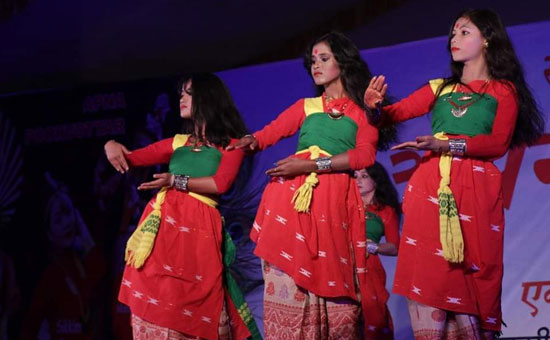
It is a traditional dance of Assam. It is associated with the worship of the Devi goddess ‘Manasa’.
As
per tradition, Behula (a character of Padma Purana) had to dance
before the Goddess Manasa to get back her husband’s (Lakhinder) life from Yamraj.
The word ‘Deodhani’ is derived from two words, i.e., ‘Deo’ meaning ‘God’ and ‘Dhani’ meaning ‘women’.
Deodhani is performed both
in solo and in groups of 3 or 4 females depending on the occasion of worship.
It depicts the dance of a women in deep trance.
The
dancers are wearing Mekhela in Muga, red blouse, different
traditional jewellery and keep their hair open during the performance. They
dance to the tune of Jaidhol (a cylindrical percussion instrument) and Khutitaal
played by Palis. This dance form depicts the process of worship of Devi Manasa.
A
striking moment of this dance is dancing with Daa (a sharp weapon used for sacrifice) and the rotating of dancers’ head in rapid circular motion with open tresses. It is believed that Deodhanis get possessed by the Goddess
in course of the dance.
8. Sattriya Mati Akharas
The
Mati Akharas are the basic exercise and grammar of Sattriya Dance which
forms the basic foundation in the training of a Sattriya dancer. Sattriya dance
has its origin in the Satras established by Mahapurush Srimanta Sankardeva
in the 15th and 16th century.
In
the post Sankarian period, there were 44 Mati Akharas but according to
Kamalabari Sattra, there are 64 Mati Akharas in use.
These basic steps and exercises prepare a dancer’s body for other complicated and choreographic numbers. The 64 Mati Akharas are again sub-divided into eight main types. They are: - Ora, Saata, Jhalak, Sitika, Pak, Jap, Lon and
Khar.
9. Bihu Dance
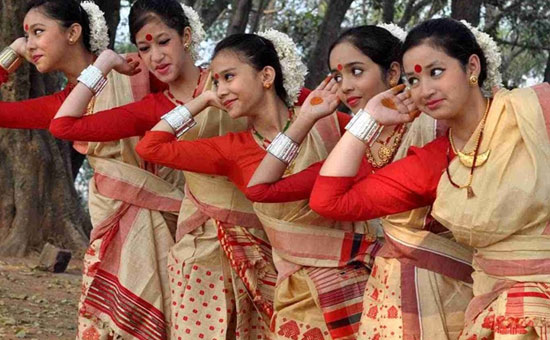
The
Bihu dance is a popular folk dance of Assam. It is performed mostly during the
annual Bihu festival in the month of April in Assam and is an integral part of
Assamese culture. It is also an important cultural event of other communities in
Assam like the Deoris, Sonowal Kacharis, Moran, Borahis etc.
There
are mainly three Bihus in Assam - Bohag Bihu or Rongali Bihu, Kati
Bihu or Kongali Bihu and Bhugali Bihu. It is performed in both
solo and group. It can performed by all ages of people, but basically the
dancers are young men and women and the dancing style is characterized by brisk
steps and rapid hand movement. The festival of Bihu is never complete without
the traditional Bihu dance.
10. Jhumur Dance
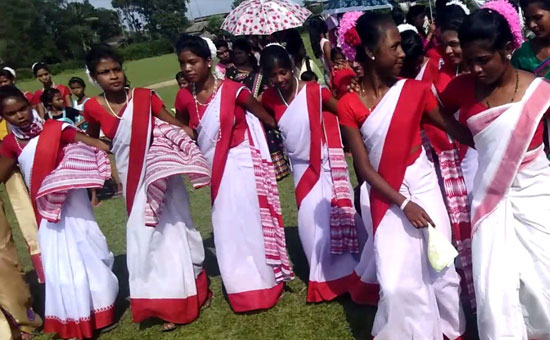
It is traditional dance form of ‘Adivasi’ or ‘Tea Tribes’ community of Assam and usually performed during autumn season in Assam.
The tea tribe’s community performed this dance on the occasion of ‘Karam Puja’ and ‘Tushu Puja’. Karam puja is a week-long celebration to
worship Karam Raja and Tushu puja is one of the important festivals of Tea
Tribes of Assam where they worship goddess Tushu. This dance is
performed by young girls and boys together.
The
girls who perform this dance are accompanied by male members to maintain the
rhythm and vocals and playing musical instruments. The male members wear long
traditional dresses and keep the rhythm with few traditional musical
instruments like a Dhol or Mandar hung on shoulders, a flute and a pair of ‘Taal’ (two metallic discs). The girls mostly perform the dancing part, holding each other’s waist and moving hands and legs forward and backward in a synchronised way.
The
dance incorporates songs and dialogues, which depict the joys and sorrows,
yearning and aspirations of the everyday life of common people.
The
above dances are performed at the park almost in every evening. This helps visitors
and especially tourists who came from the other countries will to know about Assamese
culture.
So,
I request to every reader to visit Kaziranga National Orchid and Biodiversity
Park at least once in a life time and explore the glory of beautiful Assamese culture.
Also
read
1. Teachings
of Srimanta Deva
2.
Pics
Majuli Satras
3.
About Bohang
Bihu
4.
Bonfires
of Magh Bihu